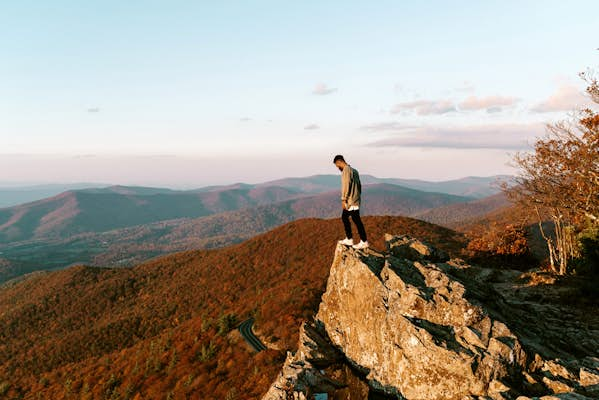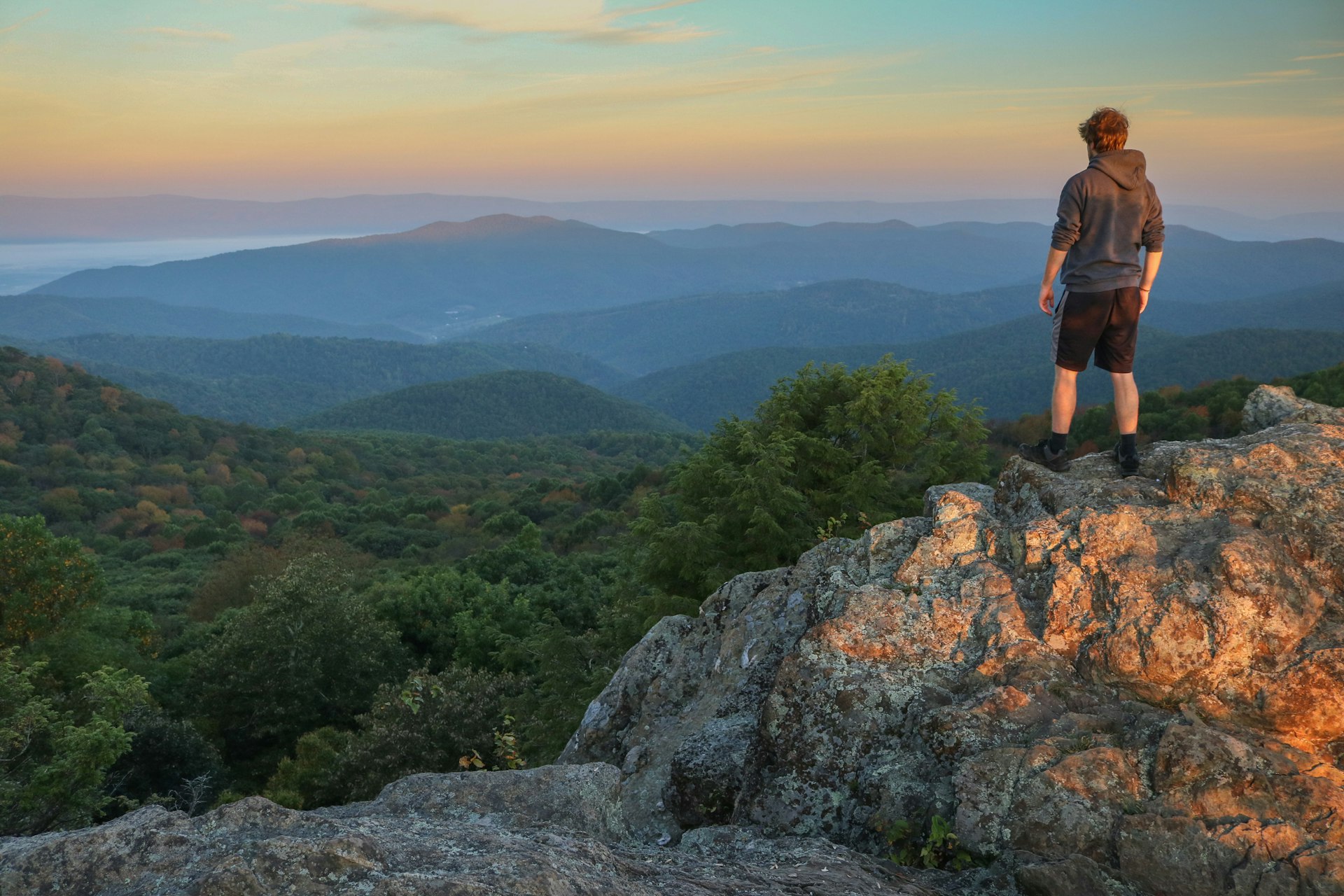
From ancient mountain ranges, dense forests and remote islands to historic forts, battlefields and national monuments, Virginia has 22 wonderful national parks calling out to modern-day explorers.
Millions of visitors flock to famous sites such as Shenandoah National Park, Colonial National Historical Park and Fredericksburg National Military Park for Virginia’s signature blend of natural beauty and history, but there are plenty of less-visited sites where you can escape the crowds.
Immerse yourself in the best experiences the world has to offer with our email newsletter delivered weekly into your inbox.
As of 2021, Virginia can also claim the honor of having the most visited site in the National Park Service system – the Blue Ridge Parkway, which logged a staggering 15.9 million visits in 2021. Whether you’re seeking spectacular views, an outdoor concert or a green, clean escape from the city, Virginia’s national parks have something for every type of traveler. Here are seven of our favorites.
9 ways to make your family trip to Virginia more fun
1. Blue Ridge Parkway
Best park for road trippers
The Blue Ridge Parkway isn’t your typical US national park — it’s actually a series of parks, stretching from the Appalachian highlands of Virginia into North Carolina’s Great Smoky Mountains National Park (which, incidentally, was America’s second most visited national park in 2021). Spanning 469 miles, the Blue Ridge Parkway covers a great deal of ground, passing through unspoiled countryside that offers a vastly different experience depending on the season, from the lush green of summer to the vivid colors of fall and snowy mountain peaks in the winter.
Built as a series of public works projects during the Great Depression, the Parkway’s natural history dates back millions of years – its forested ridges are the remains of one of the oldest mountain ranges in the world. Along the route, you’ll find scenic stops such as Humpback Rocks, the Peaks of Otter and Mabry Mill, a historic relic from 1903 that is one of the most photographed landmarks along the Parkway. Visitor’s centers, scenic overlooks, peaceful picnic sites and rewarding hiking trails offer plenty of ways to take a break from driving.
There are numerous places where you can join the Parkway – to drive the full route, start from the town of Afton, near Shenandoah National Park, or from the town of Cherokee in North Carolina, on the edge of Great Smoky Mountains National Park.
 Shenandoah National Park is classic hiking country, offering a taste of the Virginia wilds © Bram Reusen / Shutterstock
Shenandoah National Park is classic hiking country, offering a taste of the Virginia wilds © Bram Reusen / Shutterstock
2. Shenandoah National Park
Best park for hiking
Virginia’s first designated national park, Shenandoah National Park was dedicated way back in 1936. It’s part of the Blue Ridge Mountain range, but the Blue Ridge Parkway ends at the park’s entrance and the Skyline Drive takes its place. The park’s 200,000 protected acres provide a home for a wide range of wildlife, from bobcats and black bears to birds, foxes and brown bats.
Old Rag Mountain is the most popular destination in Shenandoah National Park, and it has the weekend crowds to prove it — try to visit on a weekday if you’re hiking in peak season (summer or fall). The 9.5-mile-long Old Rag hike is famously challenging, but it offers a highly rewarding view from the summit. Near the center of the park, Big Meadows is another favorite stop, a unique mountaintop meadow that’s a great place to spot wildlife, stargaze, or just meander through the wild grasses.
If you’re looking for a place to bed down for the night or a bite to eat, Skyland is a historic resort set inside Shenandoah that many people use as a hub for exploring the area.
3. George Washington Memorial Parkway
Best park for escaping the sprawl of Washington, DC
Coming in at No 6 on the National Park Service’s list of the most-visited parks, the George Washington Memorial Parkway is another scenic route built for satisfying recreational drives. Beginning just outside of Washington, DC, this 25-mile parkway links a number of significant historical sites and nature preserves threaded through Virginia, DC and Maryland and leading up to Washington’s former estate at Mt Vernon.
Nature-seekers can take their pick from some stunning natural sites, including Great Falls Park on the Virginia-Maryland border, known for its dramatic collection of rocky waterfalls. The Dyke Marsh Wildlife Preserve, one of the largest remaining freshwater tidal wetland areas in the DC area, and Turkey Run Park, part of the Potomac Gorge ecosystem, are also top stops.
 Wild ponies roam the beaches along the Assateague Island National Seashore © Vicky Faye Aquino / Shutterstock
Wild ponies roam the beaches along the Assateague Island National Seashore © Vicky Faye Aquino / Shutterstock
4. Assateague Island National Seashore
Best park for beach lovers
Although best known for its wild ponies, the barrier island of Assateague Island National Seashore is a habitat for a multitude of animals, including sika deer, ghost crabs, red fox, and many species of shorebirds. The 37-mile island stretches into Maryland, but the Virginia portion is managed by the US Fish and Wildlife Service as Chincoteague National Wildlife Refuge, with access from Virginia Beach via US 13.
This striking section of foreshore forms part of the homeland of the Pocomoke and Occohannock people, and the NPS operates a visitor’s center and recreational beach within the refuge. Besides hanging out on the beach, other popular activities on the island include camping, hiking, biking, crabbing, fishing and kayaking.
5. Colonial National Historical Park
Best park for understanding America’s origins
The Colonial National Historical Park contains two sites that encapsulate the beginning and end of colonial America. Historic Jamestowne and the Yorktown Battlefield are considered to be among the most historically significant sites in North America, connected by the 23-mile Colonial Parkway, which also passes through Colonial Williamsburg.
Although you could easily breeze through in a matter of hours, it’s worth taking a weekend to fully explore. The Cape Henry Memorial marks the landing site of the first colonists in 1607, and at Jamestowne, you can walk in the footsteps of the first permanent English settlers in North America. Meanwhile, over at the Yorktown Battlefield, you can explore the site where the first major battle of the American Revolutionary War was fought (it’s also a setting for regular re-enactments).
 Fredericksburg, Virginia, was a key battlefield during the American Civil War © Harlow Chandler / Getty Images
Fredericksburg, Virginia, was a key battlefield during the American Civil War © Harlow Chandler / Getty Images
6. Fredericksburg & Spotsylvania National Military Park
Best park for battlefield buffs
There are many significant Civil War battlefield sites in Virginia — including at Petersburg, Manassas, and Richmond – but some of the bloodiest and most tragic battles took place in Fredericksburg and the surrounding settlements of Chancellorsville, Wilderness and Spotsylvania. An estimated 15,000 men were killed and more than 85,000 were wounded on these battlefields, while farms were looted and thousands of refugees were forced into the countryside.
Today, the Fredericksburg and Spotsylvania National Military Park offers a stark reminder of why this region is still known as “America’s Battleground.” Besides the battlefields, the park contains a number of historic sites including Chatham Manor, Salem Church and the site where Stonewall Jackson died.
Visitor’s centers at the Fredericksburg Battlefield and Chancellorsville Battlefield have maps, educational exhibits, junior ranger programs and activities that help put all of the history into perspective. Trails such as the Sunken Road Walking Trail and the Jackson Wounding Trail invite visitors to wander the same routes as Civil War soldiers – a humbling experience even today.
 The Filene Center at Wolf Trap hosts everything from power-pop to jazz and blues © Kyle Gustafson / The Washington Post / Getty Images
The Filene Center at Wolf Trap hosts everything from power-pop to jazz and blues © Kyle Gustafson / The Washington Post / Getty Images
7. Wolf Trap National Park for the Performing Arts
Best park to visit in the summer
Part of the National Park System since 2002, Wolf Trap was founded as a recreational Farm Park in the 1960s following an act of Congress, but it’s evolved into a vibrant cultural hub. Today, the park represents a unique partnership between the NPS and a nonprofit arts organization. The NPS maintains the pristine grounds and buildings on-site, while Wolf Trap Foundation oversees the programming. It’s the only national park in the US dedicated to the performing arts.
Wolf Trap is less than 20 miles from Washington, DC, and it’s easily accessible by the city’s Metro system. The 117-acre park hosts more than 100 performances across a range of genres every summer, from pop and jazz to classical music and rock.
The park is also famous for its natural setting. Scattered around its green grounds are the Filene Center outdoor amphitheater, the Barns at Wolf Trap (a music venue in two converted barns), and the intimate Children’s Theatre-in-the-Woods. To explore without the crowds, try visiting in the off-season, October through April.



